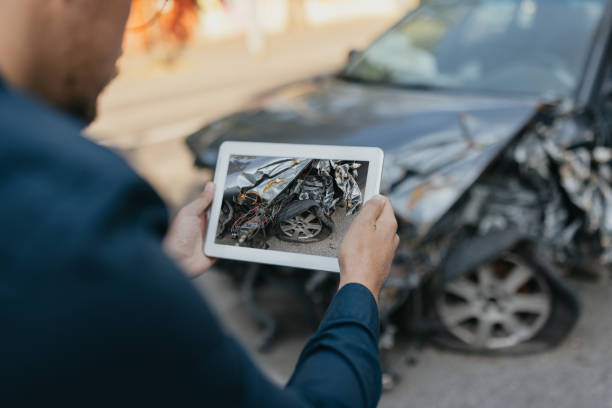You can wreck your car in many different ways. For instance, you might hit another vehicle head-on. Police call that a head-to-head collision. You might hit another car at its midpoint. That is a T-bone collision. If you have a fender bender, that means you hit the car ahead of you, meeting bumper to bumper. They may also hit you from behind.
Rear-end collision and fender bender mean the same things. In this article, we’ll talk about them in detail, and we’ll also go over how you can avoid them.
Inexperienced Drivers Often Cause Rear-End Collisions
Young drivers frequently find themselves calling their parents from streets or parking lots, panicked because they hit a car ahead or behind them. You may wonder why under-18 drivers often cause rear-end collisions. If you think about it for a moment, the answer becomes clear.
Many times rear-end collisions happen because someone misjudges how much space they have. Perhaps they’re backing into a space, and they don’t get the angle quite right. They can cause a bumper-to-bumper accident in such an instance.
An inexperienced driver, especially a teen, might also put their car in drive rather than reverse or vice versa. With the car in the wrong gear and a vehicle directly ahead of them or behind them, causing an accident becomes likely.
Teen drivers should know about these trends. They might have trouble driving in rough weather, merging on the highway, or similar difficult driving conditions. However, even when maneuvering in a parking lot or parking on the street, they can often cause a rear-end accident, so they must exercise extreme caution in these moments.
Other Situations When Rear-End Collisions Happen
Not just very young drivers cause rear-end collisions, though. Older drivers can also cause fender benders.
Some drivers reach an age where they should no longer spend any time on the road. However, it’s not easy telling an older parent or grandparent they should give up their license and sell their car. Maybe they’ve driven for five decades or longer, and they feel they can still do it, even if their cognitive abilities or their eyesight aren’t perfect anymore.
In situations where older individuals drive, they might cause car wrecks, and those certainly include rear-end accidents. If you see an older adult on the road, they might still drive perfectly well, but if they’re driving erratically, keep your distance. Such a driver might hit your vehicle and cause a fender bender, and other accident types as well.
Bad Weather
Sometimes, bad weather causes accidents, including fender benders. Maybe you’re driving in the pouring rain, driving snow, hail, sleet, or a wintery mix. It’s tough seeing the road in these conditions, and perhaps you can’t see a car ahead of you stopped at a traffic light very well.
If so, you might tap them by accident. You can easily misjudge your distance from them, especially if they don’t have their lights on. Some drivers don’t turn on their lights in bad weather, and that creates situations where fender benders and other accident types can easily occur.
Distracted Driving
Distracted driving also causes many accidents, including rear-end collisions. Lots of things might distract a driver, but we can put smartphones squarely at the top of the list.
Smartphones have become ubiquitous these days. Nearly everyone has one, even very young children. You can do many things with one, but if you’re driving, you should not let one distract you. If you’re answering a text or updating your social media status while driving, you’re endangering everyone around you.
You might also let someone in the car distract you if they’re talking loudly, singing, or kicking the back of their seat. Children often do these things, but maybe an adult distracts you if you’re having a serious discussion. Leave those talks for another time. If you’re driving, avoiding accidents means staying focused on the road ahead.
How You Can Avoid These Accident Types
If you know how these accidents occur, you can usually know what behaviors you must avoid. Don’t let a cell phone, billboard, or your passengers take away your attention while driving. If there’s bad weather, turn your lights on and drive slowly. If conditions get too bad, pull off the road and wait till they die down.
You must also watch the cars around you. See what they do. If you feel another driver might do something erratic when you’re near them, keep your distance. That’s another way you can avoid rear-end collisions and all other types as well.
Some Individuals Don’t Think Fender Benders Cause Much Damage
It’s true that if you tap a car’s bumper or they hit yours, you might walk away without a scratch. Head-to-head collisions, rollover accidents, or T-bone collisions in intersections usually cause much worse damage. However, just because these accident types don’t often cause very serious injuries, that doesn’t mean it can’t still happen.
Fender benders often cause whiplash. That occurs when your neck and head snap back and forth abruptly. When that happens, you’re jarring the vertebrae. Even if a car hits you from behind or backs up and hits you from the front, tapping your bumper, relatively little impact can still jolt your body more than you might imagine.
These soft tissue injuries can linger. You might need a neck brace in the worst cases. Sometimes, you can even sustain cracked vertebrae if you have an unusually impactful rear-end collision.
If you hit someone and cause this type of injury, they can also sue you. If they have to miss work, they might try to recoup that money by taking you to court. You may lose the case and drain your savings paying the civil penalty.
All these reasons make it obvious why you should avoid rear-end collisions if at all possible. If you’re aware of how they happen and take steps to avoid them, you’re keeping yourself and those around you safe.
Published by HOLR Magazine.


